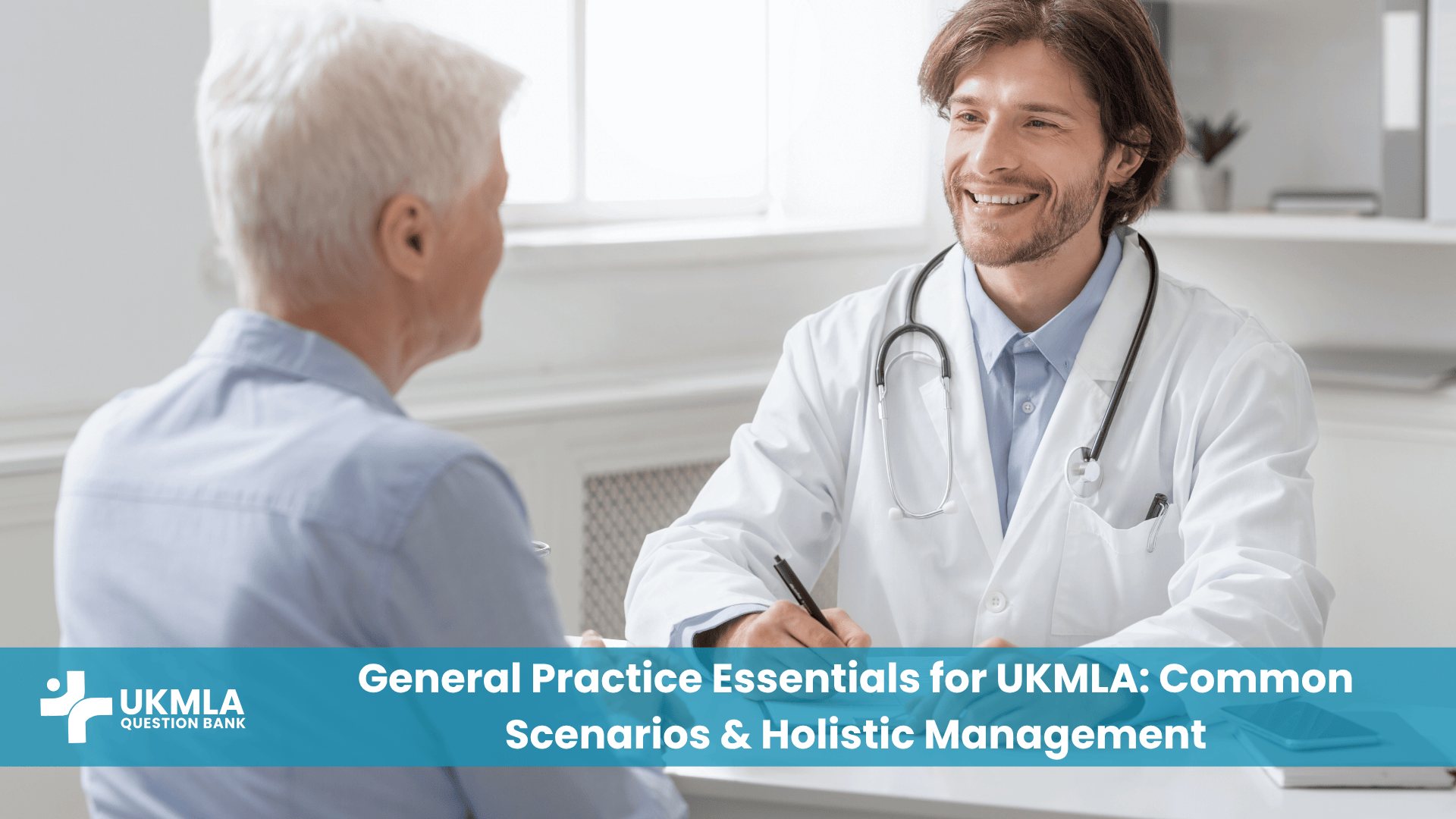Mastering the General Practice essentials for UKMLA requires a fundamental shift in thinking for many medical students. You may feel confident managing a heart attack on a coronary care unit, but how do you approach an elderly patient who keeps falling, a young person with persistent low mood, or a middle-aged professional who is simply “tired all the time”? These scenarios, which form the bedrock of primary care, demand more than just clinical knowledge; they require a holistic approach that considers the patient’s psychological, social, and personal context.
Unlike the clear-cut emergencies of hospital medicine, General Practice often deals with diagnostic uncertainty, chronic disease management, and preventative care. The UKMLA is designed to assess your fitness for this reality. It will test your ability to manage common conditions, engage in shared decision-making, and look beyond a single diagnosis to see the whole patient.
This guide will walk you through five common scenarios that embody the core principles of UK primary care. We will explore the holistic management strategies you need to know, grounding every step in the guidelines from NICE and the GMC that form the standard of care in the UK.
Key Takeaways
- Holistic Approach is Key: General Practice moves beyond a single diagnosis to consider a patient’s biopsychosocial context. This is a core competency for the UKMLA.
- Master Chronic Disease Management: A huge portion of a GP’s workload involves managing long-term conditions like diabetes and hypertension according to structured, guideline-based pathways.
- Embrace Uncertainty: Learn the principles of managing medically unexplained symptoms by focusing on excluding red flags, providing reassurance, and avoiding unnecessary investigations.
- Medication Review is Vital: Polypharmacy is a major issue, especially in the elderly. The skill of reviewing and deprescribing medications is a high-yield topic.
- Guidelines are Your Guide: Your management plans must be evidence-based. For General Practice scenarios, this means having a strong grasp of the relevant NICE guidelines.
5 Common Scenarios: Mastering the General Practice Essentials for UKMLA
1. The Elderly Patient with Falls and Polypharmacy
A common GP consultation involves an elderly patient brought in by their family after having several falls. This scenario tests your ability to perform a holistic assessment far beyond a simple injury check.
Your approach, based on current UK guidelines, should be multifactorial. The goal is to identify and modify all potential contributing factors. This includes:
- A Cardiovascular Assessment: Check for postural hypotension, arrhythmias (like AF), and carotid sinus hypersensitivity.
- A Neurological and Mobility Assessment: Look for peripheral neuropathy, assess gait and balance, and consider Parkinson’s disease or other neurological causes.
- A Vision Check: Poor eyesight is a simple but significant risk factor.
- A Home Hazard Assessment: Often done by community teams, but you should ask about rugs, poor lighting, and stairs.
- A Bone Health Assessment: Consider osteoporosis risk and the need for a FRAX score/DEXA scan.
Key Point: Polypharmacy is one of the most significant and modifiable risk factors for falls in the elderly. A thorough medication review is not just good practice; it’s an essential part of the management plan. Look for culprits like sedatives, antihypertensives, and any drug causing postural hypotension.
Table 1: Key Components of a Falls Medication Review (STOPP/START criteria principle)
| Drug Class | Action & Rationale |
|---|---|
| Benzodiazepines/Z-drugs | Consider stopping. High risk of sedation, confusion, and ataxia. |
| Antihypertensives | Review dosage. Check for postural hypotension. Aim for a less aggressive BP target if the patient is frail. |
| Alpha-blockers (e.g., Tamsulosin) | Use with caution. Well-known to cause postural hypotension. |
| Opioids & Anticholinergics | Review and reduce. Both can cause drowsiness and confusion, increasing fall risk. |
| Vitamin D & Calcium | Consider starting. If the patient is housebound or has proven osteoporosis, supplementation is key for bone health. |
2. Mental Health in Primary Care: Low Mood and Anxiety
Mental health consultations are exceedingly common in General Practice. For the UKMLA, you need to be proficient in the initial assessment and management of depression and anxiety according to the UK’s stepped-care model. A detailed approach to a patient’s story is crucial, a skill you can refine by reviewing History Taking in the UKMLA CPSA: What Examiners Look For.
Assessment:
- Use screening questionnaires: PHQ-9 for depression and GAD-7 for anxiety.
- Take a thorough history, exploring psychosocial stressors, substance use, and personal/family history of mental illness.
- Crucially, always perform a risk assessment, asking directly about thoughts of self-harm and suicide.
Key Point: The “stepped-care model” is the foundation of mental health service delivery in the UK. It means starting with the least intrusive, most effective intervention first (e.g., self-help, computerised CBT) before “stepping up” to more intensive treatments like high-intensity psychological therapy or medication.
Management:
- Step 1 (Watchful Waiting & Self-Help): For subthreshold or very mild symptoms, providing resources like self-help websites, exercise advice, and sleep hygiene is the first step.
- Step 2 (Low-Intensity Psychological Interventions): Referrals for computerised CBT (cCBT) or guided self-help are next.
- Step 3 (Medication or High-Intensity Therapy): For moderate to severe depression, offer a choice between an SSRI antidepressant (like sertraline or citalopram) OR a high-intensity psychological therapy (like CBT or counselling).
3. Managing Chronic Disease: The Type 2 Diabetes Annual Review
Managing long-term conditions is a core part of a GP’s role. The Type 2 Diabetes annual review is a perfect example of this structured, guideline-driven care. This topic is a key part of the General Practice essentials for UKMLA.
The standard approach in UK practice is a systematic check of key parameters to monitor control and screen for complications.
Table 2: The Essential Components of a T2DM Annual Review (NICE Guidelines)
| Parameter | What to Check | Target/Rationale |
|---|---|---|
| Glycaemic Control | HbA1c | Target typically 48-53 mmol/mol. Assesses long-term blood sugar control. |
| Blood Pressure | BP Reading | Target typically <140/90 mmHg (<130/80 if end-organ damage). |
| Renal Function | U&Es, eGFR, Urine Albumin:Creatinine Ratio (ACR) | To screen for diabetic nephropathy. |
| Cholesterol | Full Lipid Profile | To assess cardiovascular risk and guide statin therapy. |
| Foot Health | Sensory check (monofilament), pulses, visual inspection | To screen for peripheral neuropathy and peripheral arterial disease. |
| Eye Health | Digital Retinal Screening | To screen for diabetic retinopathy. |
| Lifestyle | Smoking status, diet, exercise, weight (BMI) | To provide education and support for self-management. |
4. Medically Unexplained Symptoms (e.g., Tired All The Time)
A significant number of GP appointments are for symptoms that, after initial assessment, have no clear organic cause. “Tired All The Time” (TATT), headaches, and non-specific abdominal pain are common examples. Your role is twofold: to be a safe clinician who rules out serious pathology, and to be a good communicator who can manage patient concerns without over-medicalising the issue.
The Approach:
- Thorough History & Red Flag Screen: Take a detailed history covering sleep, diet, mood, stress, and lifestyle. Actively screen for “red flag” symptoms (e.g., weight loss, fevers, night sweats, lymphadenopathy).
- Limited, Focused Investigations: Based on the history, perform a limited set of baseline blood tests (e.g., FBC, U&Es, LFTs, TFTs, HbA1c, Coeliac screen). Avoid a “shotgun” approach of ordering every test possible.
- Communication and Reassurance: If red flags are absent and initial tests are normal, the key is to provide clear reassurance and explanation. Acknowledge the reality of the patient’s symptoms while explaining that no serious underlying disease has been found.
- Lifestyle & Follow-up: Offer practical advice on sleep, diet, and stress management. Crucially, arrange a follow-up appointment. This “safety-netting” provides a chance to review the situation and shows the patient you are taking them seriously.
A Word from a GP Tutor: “The art of General Practice is often the art of managing uncertainty. With medically unexplained symptoms, the temptation for a student is to order a CT scan of everything. The skill of a good GP is to know when not to investigate. It’s about being safe, excluding the sinister, and then having the confidence to reassure the patient and manage the problem holistically.”
5. Contraception & Sexual Health Counselling
Providing contraceptive advice is a core competency in primary care. You are expected to have a working knowledge of the main methods available in the UK and be able to counsel a patient on their options based on their health and personal preferences. This aligns with the principles of holistic care detailed in the GMC’s ‘Good Medical Practice’ guide.
Key Counselling Points:
- Assess Suitability (UKMEC Criteria): You must be aware of key contraindications (e.g., a patient with migraines with aura should not use the combined oral contraceptive pill due to stroke risk).
- Discuss Effectiveness: Explain the difference between “perfect use” and “typical use” effectiveness rates.
- Long-Acting Reversible Contraception (LARC): NICE guidelines recommend promoting LARCs (e.g., the implant, hormonal IUS, copper IUD) as they are the most effective methods because they remove the risk of user error.
- Confidentiality: Reassure the patient, especially if they are under 16 (Fraser guidelines), about confidentiality.
Frequently Asked Questions (FAQ) Your UKMLA General Practice Questions Answered
The PHQ-9 (Patient Health Questionnaire-9) is a 9-item screening tool used to assess the severity of depressive symptoms. It is a standard part of initial mental health assessments in UK General Practice.
Deprescribing is the planned and supervised process of stopping or reducing the dose of a medication that may be causing harm or is no longer providing benefit. It is a key skill in managing polypharmacy in the elderly.
The Fraser Guidelines relate to providing contraceptive advice to patients under the age of 16 in the UK. They allow a doctor to provide advice and treatment without parental consent, provided the young person is deemed mature enough to understand the decision (i.e., ‘Gillick competent’) and certain other criteria are met.
According to NICE guidelines, the first-line antihypertensive for a patient aged over 55 or a patient of any age of Black African or Caribbean family origin is a calcium channel blocker.
It is the UK’s framework for delivering mental health services. It recommends starting with the least intrusive intervention (like self-help) and “stepping up” to more intensive treatments (like medication or high-intensity CBT) only as needed.
Many red flags are similar (weight loss, rectal bleeding), but some are specific. For example, dysphagia (difficulty swallowing) is a key red flag for oesophageal cancer, while a change in bowel habit in an older person is a red flag for colorectal cancer.
LARC stands for Long-Acting Reversible Contraception. This category includes the contraceptive implant, the hormonal IUS (intrauterine system), the copper IUD (intrauterine device), and the contraceptive injection. They are recommended as first-line options due to their high effectiveness.
You should be familiar with the main classes (SSRIs, TCAs, SNRIs) and know the names of one or two common first-line SSRIs used in UK practice, such as Sertraline and Citalopram.
A social prescriber is a non-clinical role within a GP practice. They connect patients with local community groups and services to help with social, emotional, or practical needs (e.g., referring a lonely elderly person to a local club). This is a key part of holistic care.
While all consultations should be holistic, a “holistic review” specifically implies a planned appointment (like for an elderly frail patient) that goes beyond a single presenting complaint to systematically consider their physical health, mental health, social situation, and medication all at once.
Conclusion: Embracing the Holistic Approach
The General Practice essentials for UKMLA are less about isolated facts and more about a holistic mindset. The five scenarios we’ve explored—managing falls, mental health, chronic disease, uncertainty, and sexual health—all share a common thread: they require you to look at the whole person.
Success in these stations involves combining your clinical knowledge with excellent communication skills, an understanding of the UK healthcare system (like the stepped-care model), and a commitment to evidence-based, patient-centred care. By mastering the principles behind these common GP scenarios, you will be demonstrating your readiness for safe, effective practice as a Foundation Year doctor. To see how these topics fit into the broader exam, review our guide to the Top 20 Most Frequently Tested Topics in the UKMLA AKT.
Call to Action:
Feeling more confident about primary care scenarios? The best way to solidify this knowledge is by tackling realistic practice questions. See how these principles are tested in a UKMLA Question Bank: An Essential Resource for Medical Aspirants.



